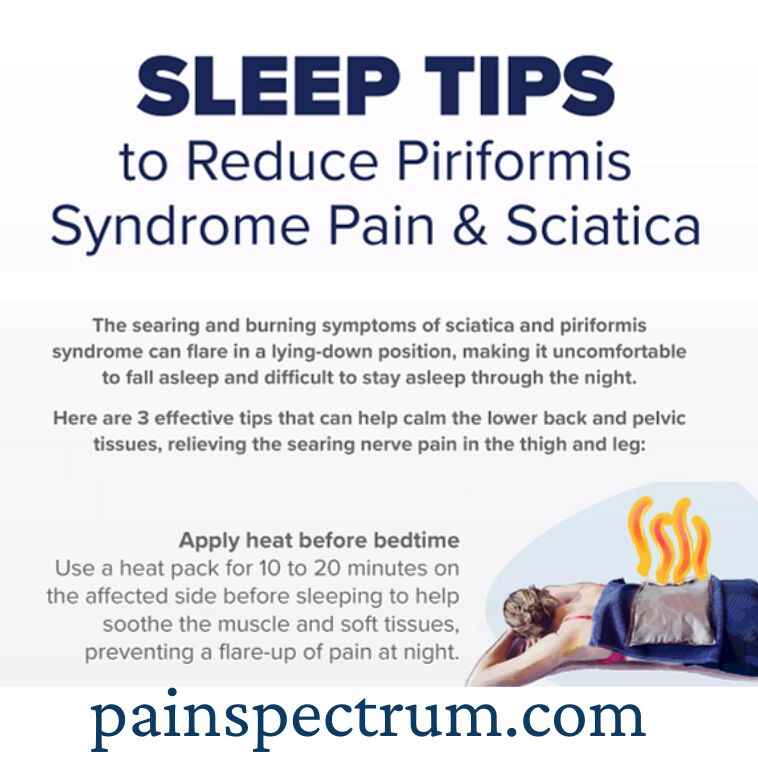
How to Sleep with Lower Back Pain and Sciatica | Best Guide
Last updated on December 6th, 2025 at 02:28 am
Lower back pain often results from muscle strain, injury, or poor posture. It may radiate to the buttocks and legs, a condition known as sciatica when the sciatic nerve, which runs from the lower back through the hips and down each leg, is irritated or compressed.
Table of Contents
Symptoms of Sciatica
- Sharp leg pain: Shooting pain from the lower back to the leg.
- Numbness: Loss of feeling in the leg or foot.
- Tingling: Pins-and-needles feeling in the leg or foot.
- Weakness: Weak muscles in the leg.
- Burning: Burning pain in the lower back or leg.
- Pain with movement: Pain worsens when moving.
- Difficulty standing: Trouble standing up due to pain.
- Reduced reflexes: Decreased knee or ankle reflexes.
Causes of Lower Back Pain and Sciatica
| Condition | Description |
|---|---|
| Herniated Disc | When the soft part inside a spinal disc bulges out and presses on nerves, causing pain that radiates down the leg (sciatica). |
| Degenerative Disc Disease | As discs between vertebrae age, they become less flexible and lead to stiffness and pain in the lower back. |
| Spinal Stenosis | Narrowing of the spinal canal or nerve openings, which compresses the spinal cord or nerves and causes pain, numbness, or weakness in the legs. |
| Spondylolisthesis | A condition where a vertebra slips out of place and presses on nerves, resulting in lower back pain. |
| Muscle Strain | Overuse, improper lifting, or sudden movements strain back muscles and ligaments, causing acute or chronic lower back pain. |
| Piriformis Syndrome | Irritation of the piriformis muscle deep in the buttocks compresses the sciatic nerve, leading to pain similar to sciatica. |
| Spinal Tumors | Rare growths in the spine press on nerves, causing pain that may radiate to the lower back and legs. |
| Trauma or Injury | Accidents, falls, or sports injuries can cause fractures, sprains, or strains in the spine, resulting in lower back pain. |
| Osteoarthritis | Wear and tear on spine joints and discs cause arthritis, resulting in pain and stiffness in the lower back. |
Why Lower Back Pain and Sciatica are Worse at Night

Lower back pain and sciatica often feel worse at night for a few reasons. When you lie down, certain positions can put pressure on your back and sciatic nerve, causing more pain. Staying in one position for a long time can make your muscles stiff and sore.
Inflammation from the day’s activities can build up and become more noticeable when you’re trying to rest. Stress and tension can also cause muscles to tighten up, adding to the pain. If your mattress or pillow doesn’t support your back well, it can make the pain worse.
Cooler nighttime temperatures can make muscles stiffen, leading to more discomfort. Lastly, activities during the day, like sitting too long or lifting heavy things, can irritate your back and sciatic nerve, causing more pain when you go to bed.
Role of Sleep in Healing Lower Back Pain and Sciatica

Sleep plays a crucial role in healing lower back pain and sciatica. During sleep, your body repairs tissues, reduces inflammation and restores energy, which helps alleviate pain. Good sleep also helps relax muscles and relieve tension, which can reduce discomfort.
Proper sleep positions and a supportive mattress can improve spinal alignment, preventing further irritation of the sciatic nerve. Getting enough restful sleep can boost your immune system and improve your overall health, aiding in faster recovery from back pain and sciatica. Therefore, prioritizing good sleep habits is essential for managing and healing these conditions.
Poor Sleep Quality on Lower Back Pain
| Impact of Poor Sleep Quality on Lower Back Pain | Description |
|---|---|
| Increased Muscle Tension | Sleep deprivation can cause muscles to become tense and stiff, exacerbating lower back pain. |
| Heightened Inflammation Levels | Inadequate sleep leads to higher inflammation levels, which can intensify existing back pain. |
| Greater Pain Sensitivity | Lack of sleep can lower your pain threshold, making lower back pain feel more severe. |
| Delayed Healing | Sleep is crucial for the body’s healing processes; poor sleep quality can delay recovery from back pain and sciatica. |
| Mental Health Impact | Fatigue and stress from poor sleep can contribute to muscle tension and worsen lower back pain. |
Best Sleeping Positions for Lower Back Pain and Sciatica Relief
Neutral Spine Position: Align your spine by lying on your back with a pillow under your knees. This reduces pressure on the lower back and helps maintain its natural curve.

Side Sleeping with Knee Support: Lie on your side and place a pillow between your knees to keep your hips, pelvis, and spine aligned. This position alleviates strain on the lower back and can ease sciatica pain.
Fetal Position: Curl up on your side with your knees drawn toward your chest. This position may create space between the vertebrae, potentially reducing nerve pressure.
Reclined Position: Use an adjustable bed or recliner to find a comfortable angle that supports your back’s natural curvature, especially beneficial for conditions like spondylolisthesis.
Read More: Relieve Sciatica Pain in Bed
Tips for Avoiding Twisted Positions During Sleep
| Tip | Description |
|---|---|
| Keep Your Spine Aligned | Ensure your head, neck, and back are in a straight line using supportive pillows. |
| Use a Body Pillow | Helps keep your spine straight and prevents twisting during the night. |
| Avoid Sleeping on Your Stomach | This position can cause spine twisting; use a pillow under hips if necessary. |
| Turn Your Whole Body | Move your entire body at once when turning over to avoid twisting your spine. |
| Support Your Legs | Place a pillow between your knees if sleeping on your side to maintain alignment. |
Worst Sleeping Positions for Lower Back Pain and Sciatica

Sleeping on Your Stomach: This position can cause your spine to twist and increase pressure on your lower back and sciatic nerve, leading to more pain and discomfort.
Twisted Positions: Sleeping in a twisted position, where your spine is not aligned, can strain your back muscles and aggravate sciatica symptoms.
Unsupported Back: Sleeping without proper support for your lower back can lead to poor spinal alignment and increased pain.
Flat on Your Back Without Knee Support: While sleeping on your back can be good, not supporting your knees can cause your lower back to arch excessively, increasing pain.
Alternatives for Sciatica Pain Relief Before Bed
For sciatica pain relief before bed, try a few simple methods. Gentle stretching exercises can help loosen tight muscles in your lower back and legs. Using a heating pad or a warm towel on your lower back can relax your muscles, while an ice pack can reduce inflammation and numb the pain. Over-the-counter pain relievers like ibuprofen can also help.
Make sure your mattress and pillows provide good support to keep your spine aligned. Relaxation techniques such as deep breathing, meditation, or gentle yoga can reduce stress and muscle tension.
Additionally, a gentle massage before bed can help relax your muscles and reduce pressure on the sciatic nerve. Adjust your sleeping position by using pillows to support your knees and lower back for better alignment and less pain. These steps can make a big difference in reducing sciatica pain and improving your sleep.
Investing in a Quality Mattress

Investing in a quality mattress can significantly impact your sleep quality, especially if you suffer from lower back pain and sciatica. A helpful mattress that conforms to your body’s natural curves helps alleviate pressure points and helps proper spinal position. Look for mattresses designed specifically for persons with back pain, or those that offer customizable resolve levels to suit your needs.
Maintaining a Consistent Nighttime Routine
Maintaining a consistent nighttime routine can help signal to your body that it’s time to wind down and prepare for sleep. Founding a regular sleep schedule, avoiding stimulating activities before bed, and creating a relaxing bedtime routine can improve sleep quality and reduce the likelihood of experiencing disruptions due to lower back pain and sciatica.
Considering Personal Care Equipment for Comfort
Considering personal care equipment, such as ergonomic pillows or mattress toppers, can improve your comfort and support while sleeping with lower back pain and sciatica. Ergonomic pillows designed to support the natural curvature of the spine or alleviate pressure on specific areas can help relieve discomfort and promote better sleep posture. As well, mattress toppers made from memory foam or other helpful materials can provide extra stifling and support for sensitive areas.
When to Seek Medical Attention for Lower Back Pain and Sciatica
It’s important to know when to seek medical attention for lower back pain and sciatica. You should see a doctor if your pain is severe and not improving with home treatments, or if it started suddenly after an injury or accident. Persistent pain lasting more than a few weeks is another sign that you should get medical help.
Additionally, if you experience numbness, tingling, or weakness in your legs or feet, or if you have trouble controlling your bladder or bowels, you should seek immediate medical attention.
Other warning signs include having a fever along with your back pain or losing weight without trying, as these could indicate a more serious condition. Recognizing these symptoms and seeking prompt medical care can help prevent complications and ensure you receive the appropriate treatment.
Treatment Options for Lower Back Pain and Sciatica
Lower back pain and sciatica can be effectively managed through various treatment options. Physical therapy is beneficial for strengthening muscles and improving flexibility, while medications like over-the-counter pain relievers and muscle relaxants can alleviate discomfort. Steroid injections may be used to reduce inflammation around the affected nerves.
Alternative therapies such as acupuncture and chiropractic care offer additional relief. Lifestyle changes, including regular exercise, maintaining a healthy weight, and improving posture, can prevent worsening symptoms.
One notable method for managing sciatica pain is the use of a TENS Unit for Sciatica Pain. Transcutaneous Electrical Nerve Stimulation (TENS) units work by sending electrical impulses through the skin to disrupt pain signals and stimulate endorphin production. This non-invasive treatment can provide significant relief for individuals suffering from sciatica.
In severe cases, surgical procedures like discectomy or spinal fusion may be necessary. Cognitive Behavioral Therapy (CBT) and supportive devices like back braces also play roles in managing pain and promoting recovery. It’s essential to consult with a healthcare provider to determine the most suitable treatment plan for individual needs.
Conclusion
Managing lower back pain and sciatica for better sleep involves understanding the conditions and approving suitable sleeping positions and pre-bedtime practices. By avoiding harmful sleeping positions and using alternatives like gentle stretches and hot baths, you can relieve discomfort. Lifestyle changes such as investing in a quality mattress and maintaining a consistent nighttime routine are also crucial for improving sleep quality. However, if symptoms persist or worsen, seeking medical attention from spine specialists is essential to ensure proper diagnosis and treatment. Remember, prioritizing sleep and adopting healthy habits can greatly contribute to your overall well-being and quality of life.


